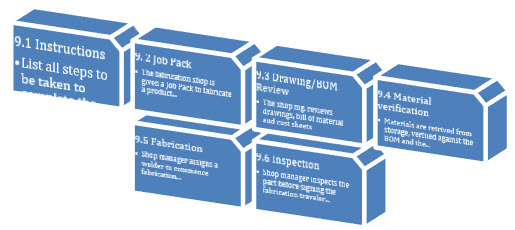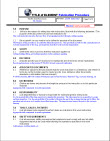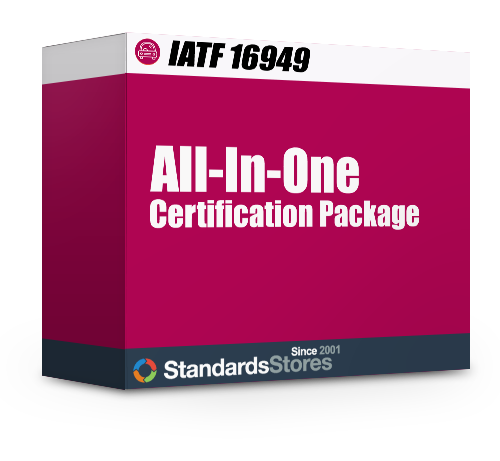Processes, Procedures and Work Instructions
As a result of IATF 16949 following the changes of ISO 9001, the strict requirements of the QMS have been relaxed to help satisfy the remaining documentation requirements. Despite the relaxation of the strict requirements, the Processes, Procedures and Work Instructions are typically still employed. Within the QMS the words processes, procedures and work instructions often get confusing and therefore we have taken the time to define these terms in order for a better experience and better understanding of the QMS.
The Relationship Between Processes, Procedures and Work Instructions
Documenting a QMS allows an organization to clearly and concisely identify their processes, procedures and work instructions in order to explain and control how it meets the requirements for IATF 16949. This begins by thoroughly understanding these terms and how to categorize them within the workings of a management system, in other words:
A process states what needs to be done and why
A procedure states how the process needs to be done
A work instruction explains how to carry out the procedure.
A process is considered a high level, strategic method of control, in effect a summary of objectives, with specifications and broad resources needed. The procedure adds more specifics. This includes: responsibilities, specific tools, methods and measurements. Work instruction is a step-by-step guideline which allows organizations to implement the processes and procedures.
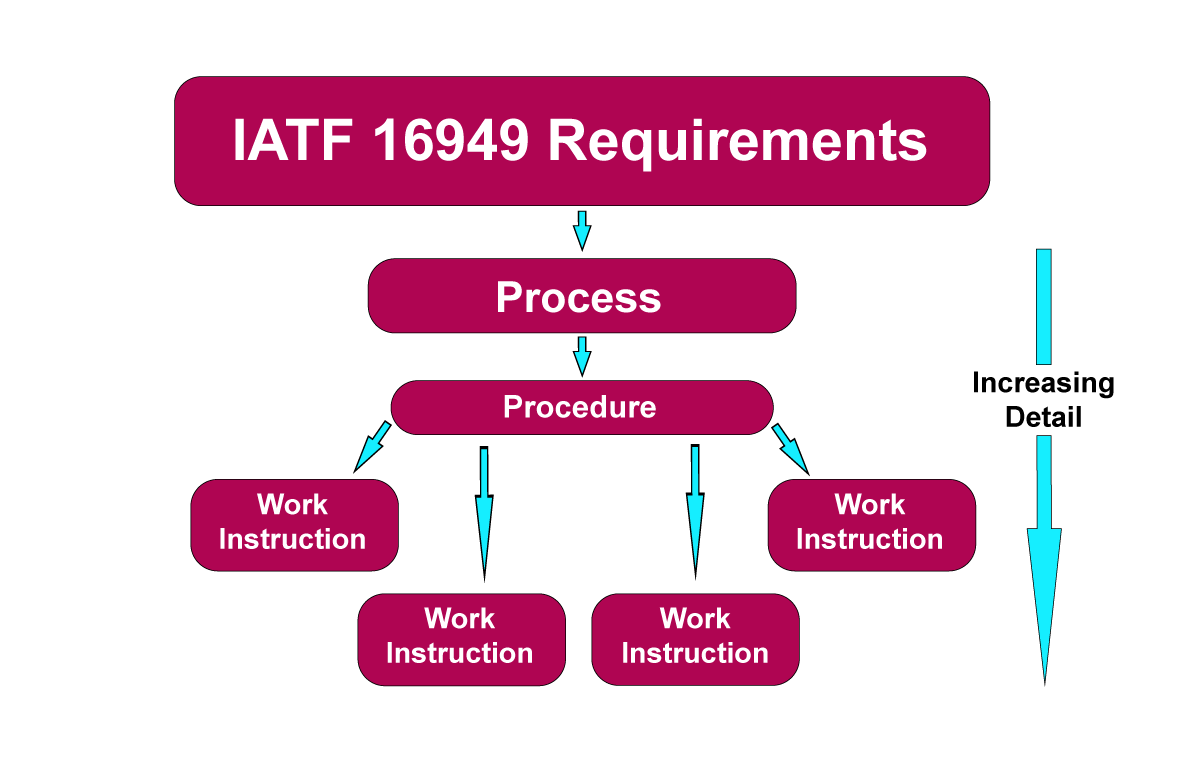
In order to have control of your QMS, detailed action levels created in the form or processes, procedures and work instructions. These levels are typically created to satisfy a requirement by the QMS.
The Process, Procedure and Work Instruction hierarchy
Some basic guidelines for remembering the differences between these terms when documenting your quality management system:
- Begin with the processes you are required to document. Usually the number of processes dictates the number of procedures. While the situation dictates the exact number of procedures necessary to control the desired outcome, it is a good rule of thumb to not create more procedures than requirements.
- Typically a procedure shall be created for every process. The majority of companies write too many procedures, when in actuality they should be documenting these directives as more specific work instructions.
- When necessary, create detailed work instructions for each task that is needed to support each procedure.
Process
A process is any activity or set of activities that uses resources to transform inputs into outputs can be considered a process. The IATF 16949 following ISO 9001 is based off of a process approach.
Processes must have defined and ideally measurable objectives, inputs, outputs, activities and resources. When you are defining a process you want to have several key elements present including:
- Inputs/Resources:
- Specified requirements (needs), for example:
- What information do you need to start work?
- Where does that information come from?
- Specified requirements (needs), for example:
- Activities:
- Interrelated or interacting activities that use resources needed to achieve a specific output
- All of the operations, activities and sub-processes carried out to produce the desired result, for example:
- What are the basic jobs carried out in your department?
- Can you explain to me your operations here?
- Outputs:
- Satisfied requirements (results), for example:
- Who receives the result of your work?
- How do you know if you’ve done your job correctly? (met objectives)
- Satisfied requirements (results), for example:
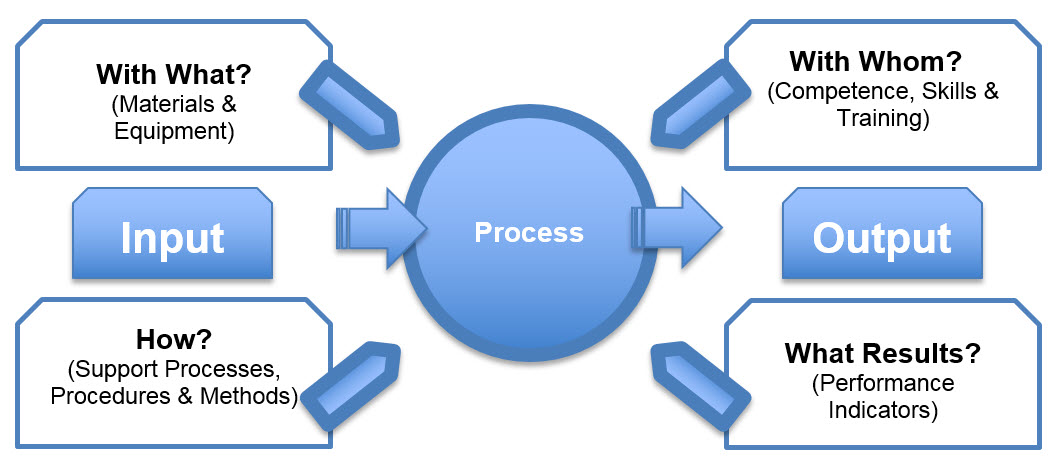
- Operations management processes
- Resource management processes
- Planning processes
- Documentation processes (such as those used for direct production or service provision)
One of the main intents (and results) of employing well-constructed processes is to unify the working of the organization across vertical functions, with the main purpose being centered around customer satisfaction. By exposing and documenting specific end-to-end process interaction, a higher order result can be achieved by proper management techniques (i.e. training, measurement, incentives/rewards, etc.)

Process Example: Hiring a contractor. Input- You want to formulate a plan, determine a budget and a time table. Process- you want to find a reliable contractor and understand their capabilities, review performance, check their availability and obtain a quotes. Output- Contract acceptance, finalize schedule and create payment milestones.
Procedure
A procedure is a uniform method that outlines how to perform a process, for example, how you control your suppliers. Containing elements such as:
- Why the procedure is required
- What needs to be accomplished and how it will be executed
- Who performs what action
- Where the inputs come from and where the outputs go
- Any locational requirements (i.e. where an activity is performed)
- The criteria (requirements) they must meet
- Tools, information or other resources required
- Terminology, definitions, explanations, etc.
Requirements and supporting processes for IATF 16949 are found in the ISO 9001 standard and the IATF 16949 supplementary standard. The mandate for creating specific procedures has been removed and replaced with the term “Documented information”. Despite this change, it does not lessen the need for or the effectiveness of, formally specifying procedures. Procedures are used when there is a definite operation that should be followed on a consistent basis.
Procedure Example: An example procedure for an organization may be one that is important for mission critical industries like automotive. The procedure could outline a formal process used for communicating with customers and reviewing information from the customer, including customer feedback.
Procedures make up the core documentation for the QMS that helps run the system with more conformity, consistency and predictability. The procedures of your organization will describe how you operate and control your business and meet the requirements of IATF 16949, even through changes such as personnel changes, supplier replacements, and fluctuating customer requirements/expectations, etc.
A procedure offers a general description of how a company meets a process requirement, but doesn’t include the company-specific details for execution. These specific directives an employee needs to carry out company tasks are work instructions (see below).
Work Instruction
A work instruction describes how to perform a task within a process. This is a more detailed portion of the procedure, work instructions are great because they are both organizational and explanatory:
- There are many times more detail needed than what is provided in the procedures. Work instructions are greatly helpful because they provide detail specific tasks which are referenced in the procedure, they aid in training and help reduce mistakes because they provide step-by-step instructions needed for accomplishing something that may be missing from more generally drafted procedures.
- The division between procedure and work instruction can be a great organizational tool if there is an advantage to dividing up procedure(s) into many “sub-procedures” that are related, but cover different aspects.
A work instruction will often repeat many of the elements of a procedure to help describe where it fits into the process such as:
- Purpose
- Definitions
- Responsibility
- Requirements
- Tools and information
But at its core, a work instruction contains the step-by-step detail that is not advantageous to put into a procedure because it requires such a limited scope.
Work Instruction Example: A welding-based fabrication assembly set of work instructions might contain step-by-step instructions for completing a final fabrication. Instructions may include cutting, drilling, welding, inspection, inventory management etc. For more information, click on the image above.
There is no mandate to create work instructions. However, years of QMS documentation has shown that coupling these in the documentation hierarchy can have greater effects for your QMS.
Please note that certain text from the ISO 9001 standard is only used for instructional purposes. Standard Stores recognizes and respects the International Organization for Standardization (ISO) copyright and intellectual property guidelines.




